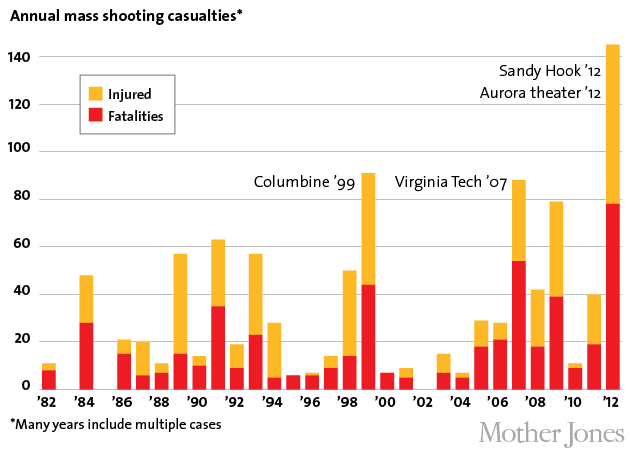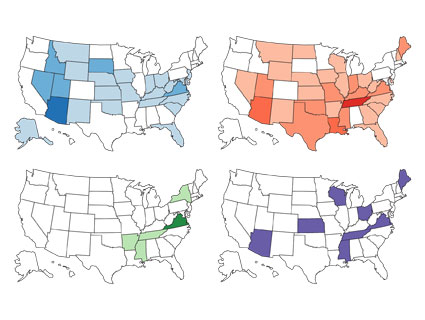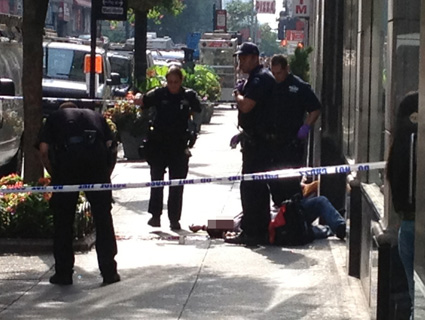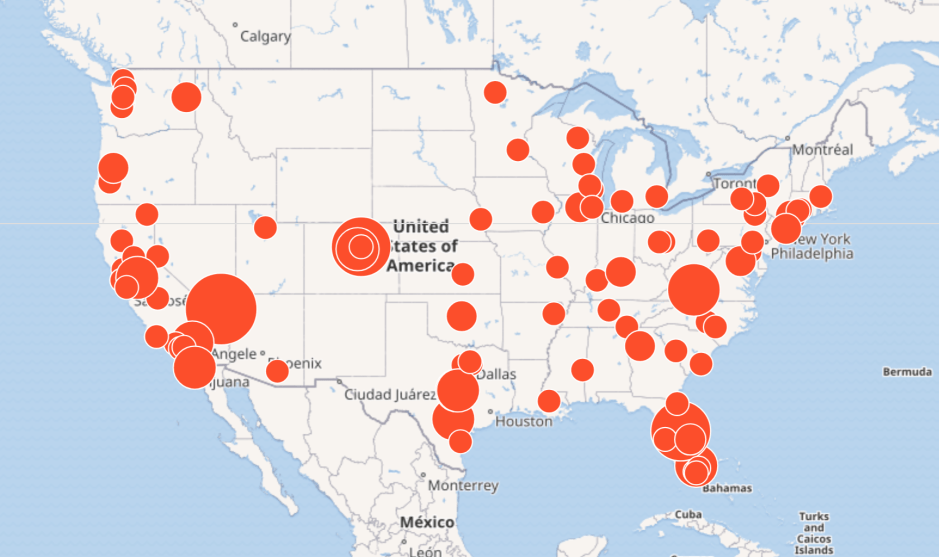
In the fierce debate that always follows the latest mass shooting, it’s an argument you hear frequently from gun rights promoters: If only more people were armed, there would be a better chance of stopping these terrible events. This has plausibility problems—what are the odds that, say, a moviegoer with a pack of Twizzlers in one pocket and a Glock in the other would be mentally prepared, properly positioned, and skilled enough to take out a body-armored assailant in a smoke- and panic-filled theater?
But whether you believe that would happen is ultimately a matter of theory and speculation. Instead, let’s look at some facts gathered in a five-month investigation by Mother Jones.
In the wake of the massacres this year at a Colorado movie theater, a Sikh temple in Wisconsin, and Sandy Hook Elementary School in Connecticut, we set out to track mass shootings in the United States over the past 30 years. We identified and analyzed 62 of them, and one striking pattern in the data is this: In not a single case was the killing stopped by a civilian using a gun. And in other recent (but less lethal) rampages in which armed civilians attempted to intervene, those civilians not only failed to stop the shooter but also were gravely wounded or killed. Moreover, we found that the rate of mass shootings has increased in recent years—at a time when America has been flooded with millions of additional firearms and a barrage of new laws has made it easier than ever to carry them in public places, including bars, parks, and schools.
America has long been heavily armed relative to other societies, and our arsenal keeps growing. A precise count isn’t possible because most guns in the United States aren’t registered and the government has scant ability to track them, thanks to a legislative landscape shaped by powerful pro-gun groups such as the National Rifle Association. But through a combination of national surveys and manufacturing and sales data, we know that the increase in firearms has far outpaced population growth. In 1995 there were an estimated 200 million guns in private hands. Today, there are around 300 million—about a 50 percent jump. The US population, now over 314 million, grew by about 20 percent in that period. At this rate, there will be a gun for every man, woman, and child before the decade ends.
There is no evidence indicating that arming Americans further will help prevent mass shootings or reduce the carnage, says Dr. Stephen Hargarten, a leading expert on emergency medicine and gun violence at the Medical College of Wisconsin. To the contrary, there appears to be a relationship between the proliferation of firearms and a rise in mass shootings: By our count, there have been two per year on average since 1982. Yet, 25 of the 62 cases we examined have occurred since 2006. In 2012 alone there have been seven mass shootings, and a record number of casualties, with more than 140 people injured and killed.
Armed civilians attempting to intervene are actually more likely to increase the bloodshed, says Hargarten, “given that civilian shooters are less likely to hit their targets than police in these circumstances.” A chaotic scene in August at the Empire State Building put this starkly into perspective when New York City police officers trained in counterterrorism confronted a gunman and wounded nine innocent bystanders in the process.
Surveys suggest America’s guns may be concentrated in fewer hands today: Approximately 40 percent of households had them in the past decade, versus about 50 percent in the 1980s. But far more relevant is a recent barrage of laws that have rolled back gun restrictions throughout the country. In the past four years, across 37 states, the NRA and its political allies have pushed through 99 laws making guns easier to own, carry, and conceal from the government.
Among the more striking measures: Eight states now allow firearms in bars. Law-abiding Missourians can carry a gun while intoxicated and even fire it if “acting in self-defense.” In Kansas, permit holders can carry concealed weapons inside K-12 schools, and Louisiana allows them in houses of worship. Virginia not only repealed a law requiring handgun vendors to submit sales records, but the state also ordered the destruction of all such previous records. More than two-thirds of these laws were passed by Republican-controlled statehouses, though often with bipartisan support.
The laws have caused dramatic changes, including in the two states hit with the recent carnage. Colorado passed its concealed-carry measure in 2003, issuing 9,522 permits that year; by the end of last year the state had handed out a total of just under 120,000, according to data we obtained from the County Sheriffs of Colorado. In March of this year, the Colorado Supreme Court ruled that concealed weapons are legal on the state’s college campuses. (It is now the fifth state explicitly allowing them.) If former neuroscience student James Holmes were still attending the University of Colorado today, the movie theater killer—who had no criminal history and obtained his weapons legally—could’ve gotten a permit to tote his pair of .40 caliber Glocks straight into the student union. Wisconsin’s concealed-carry law went into effect just nine months before the Sikh temple shooting in suburban Milwaukee this August. During that time, the state issued a whopping 122,506 permits, according to data from Wisconsin’s Department of Justice. The new law authorizes guns on college campuses, as well as in bars, state parks, and some government buildings.
And we’re on our way to a situation where the most lax state permitting rules—say, Virginia’s, where an online course now qualifies for firearms safety training and has drawn a flood of out-of-state applicants—are in effect national law. Eighty percent of states now recognize handgun permits from at least some other states. And gun rights activists are pushing hard for a federal reciprocity bill—passed in the House late last year, with GOP vice presidential candidate Paul Ryan among its most ardent supporters—that would essentially make any state’s permits valid nationwide.
Indeed, the country’s vast arsenal of handguns—at least 118 million of them as of 2010—is increasingly mobile, with 69 of the 99 new state laws making them easier to carry. A decade ago, seven states and the District of Columbia still prohibited concealed handguns; today, it’s down to just Illinois and DC. (And Illinois recently passed an exception cracking the door open to carrying). In the 62 mass shootings we analyzed, 54 of the killers had handguns—including in all 15 of the mass shootings since the surge of pro-gun laws began in 2009.
In a certain sense the law was on their side: nearly 80 percent of the killers in our investigation obtained their weapons legally.
We used a conservative set of criteria to build a comprehensive rundown of high-profile attacks in public places—at schools, workplaces, government buildings, shopping malls—though they represent only a small fraction of the nation’s overall gun violence. The FBI defines a mass murderer as someone who kills four or more people in a single incident, usually in one location. (As opposed to spree or serial killers, who strike multiple times.) We excluded cases involving armed robberies or gang violence; dropping the number of fatalities by just one, or including those motives, would add many, many more cases. (More about our criteria here.)
There was one case in our data set in which an armed civilian played a role. Back in 1982, a man opened fire at a welding shop in Miami, killing eight and wounding three others before fleeing on a bicycle. A civilian who worked nearby pursued the assailant in a car, shooting and killing him a few blocks away (in addition to ramming him with the car). Florida authorities, led by then-state attorney Janet Reno, concluded that the vigilante had used force justifiably, and speculated that he may have prevented additional killings. But even if we were to count that case as a successful armed intervention by a civilian, it would account for just 1.6 percent of the mass shootings in the last 30 years.
More broadly, attempts by armed civilians to stop shooting rampages are rare—and successful ones even rarer. There were two school shootings in the late 1990s, in Mississippi and Pennsylvania, in which bystanders with guns ultimately subdued the teen perpetrators, but in both cases it was after the shooting had subsided. Other cases led to tragic results. In 2005, as a rampage unfolded inside a shopping mall in Tacoma, Washington, a civilian named Brendan McKown confronted the assailant with a licensed handgun he was carrying. The assailant pumped several bullets into McKown and wounded six people before eventually surrendering to police after a hostage standoff. (A comatose McKown eventually recovered after weeks in the hospital.) In Tyler, Texas, that same year, a civilian named Mark Wilson fired his licensed handgun at a man on a rampage at the county courthouse. Wilson—who was a firearms instructor—was shot dead by the body-armored assailant, who wielded an AK-47. (None of these cases were included in our mass shootings data set because fewer than four victims died in each.)
Appeals to heroism on this subject abound. So does misleading information. Gun rights die-hards frequently credit the end of a rampage in 2002 at the Appalachian School of Law in Virginia to armed “students” who intervened—while failing to disclose that those students were also current and former law enforcement officers, and that the killer, according to police investigators, was out of bullets by the time they got to him. It’s one of several cases commonly cited as examples of ordinary folks with guns stopping massacres that do not stand up to scrutiny.
How do law enforcement authorities view armed civilians getting involved? One week after the slaughter at the Dark Knight screening in July, the city of Houston—hardly a hotbed of gun control—released a new Department of Homeland Security-funded video instructing the public on how to react to such events. The six-minute production foremost advises running away or otherwise hiding, and suggests fighting back only as a last resort. It makes no mention of civilians using firearms. Screen shot: City of Houston video on mass shooters.
Screen shot: City of Houston video on mass shooters.
Law enforcement officials are the first to say that civilians should not be allowed to obtain particularly lethal weaponry, such as the AR-15 assault rifle and ultra-high-capacity, drum-style magazine used by Holmes to mow down Batman fans. The expiration of the Federal Assault Weapons Ban under President George W. Bush in 2004 has not helped that cause: Seven killers since then have wielded assault weapons in mass shootings.
But while access to weapons is a crucial consideration for stemming the violence, stricter gun laws are no silver bullet. Another key factor is mental illness. A major New York Times investigation in 2000 examined 100 shooting rampages and found that at least half of the killers showed signs of serious mental health problems. Our own data analysis reveals that the majority of mass shootings are murder-suicides: In the 62 cases we analyzed, 36 of the shooters killed themselves. Others may have committed “suicide by cop”—seven died in police shootouts. Still others simply waited, as Holmes did in the movie theater parking lot, to be apprehended by authorities.  Drum-style magazine for assault rifles Brownells.com
Drum-style magazine for assault rifles Brownells.com
Mental illness among the killers is no surprise, ranging from paranoid schizophrenia to suicidal depression. But while some states have improved their sharing of mental health records with federal authorities, millions of records reportedly are still missing from the FBI’s database for criminal background checks.
Hargarten of the Medical College of Wisconsin argues that mass shootings need to be scrutinized as a public health emergency so that policy makers can better focus on controlling the epidemic of violence. It would be no different than if there were an outbreak of Ebola virus, he says—we’d be assembling the nation’s foremost experts to stop it.
But real progress will require transcending hardened politics. For decades gun rights promoters have framed measures aimed at public safety—background checks, waiting periods for purchases, tracking of firearms—as dire attacks on constitutional freedom. They’ve wielded the gun issue so successfully as a political weapon that Democrats hardly dare to touch it, while Republicans have gone to new extremes in their party platform to enshrine gun rights. Political leaders have failed to advance the discussion “in a credible, thoughtful, evidence-driven way,” says Hargarten.
In the meantime, the gun violence in malls and schools and religious venues continues apace. As a superintendent told his community in suburban Cleveland this February, after a shooter at Chardon High School snuffed out the lives of three students and injured three others, “We’re not just any old place, Chardon. This is every place. As you’ve seen in the past, this can happen anywhere.”
Additional research contributed by Deanna Pan and Gavin Aronsen.















